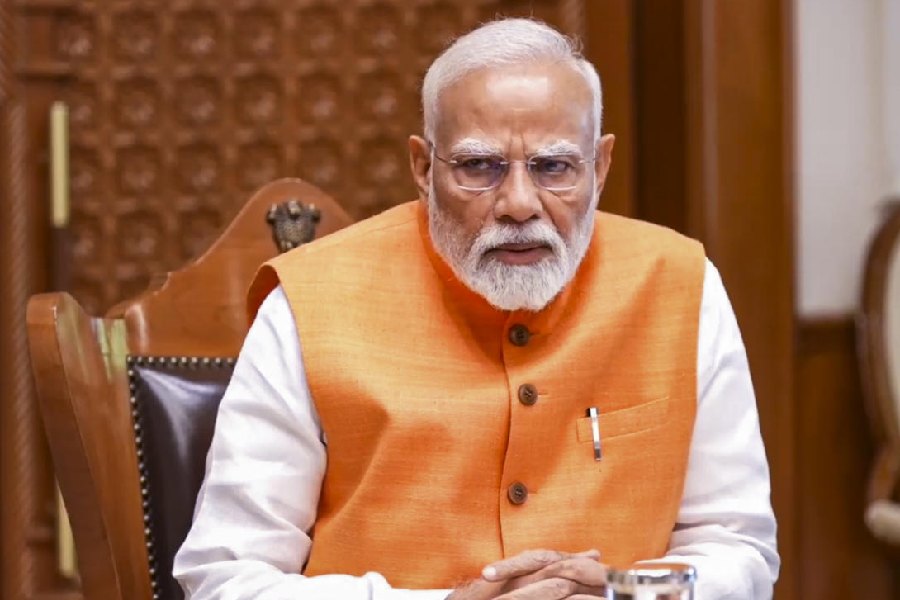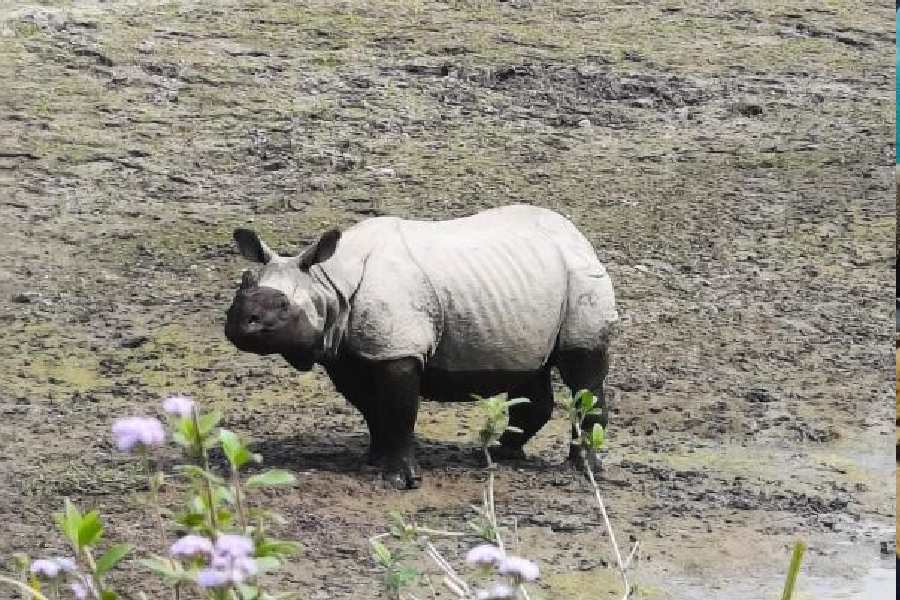 |
| BLACK DIAMOND: An army of local villagers busy looting coal from a rake in the Hazratpur dump yard of Borjore in Birbhum on Tuesday afternoon. Picture by Sanjoy Chattopadhyaya |
Scene I: A 59-wagon rake gets filled with coal in a dump yard, around 270km from Calcutta, on a scorching April afternoon, in about two hours.
Scene II: Over 5,000 looters mount the coal wagons — in full view of over 500 policemen — and empty them out by filling up gunny bags and bamboo baskets in less than three hours.
Scene III: The rake chugs out of the dump yard and the looters leave with their booty while cops look the other way.
These scenes are enacted almost every day in a coal dump yard in Hazratpur of Borjore, a village along the Birbhum-Burdwan border, and lakhs of people in Calcutta and across the state pay the price with long hours of power cuts.
 |
| Cops stand guard during the loot. (Sanjoy Chattopadhyaya) |
But there are a few thousand beneficiaries like Koimuddin Sheikh, a part-time farmer who can plough his land only during the monsoon. Whenever a rake gets filled at the dump yard outside the Bengal EMTA Coal Mines Limited (BECML)-owned coal mine in Borjore, he goes back to Sahapur village with a smile.
“I will get around Rs 550 from three bags. The police do not stop us from selling coal to other dump yards as we buy tokens from the cops to ferry the consignments,” says Sheikh after a busy day’s loot.
 |
| PASSPORT FOR PLUNDER: A token with a horse symbol, date and Kh printed on it provides immunity from police scrutiny. Residents say Kh stands for Khoirasole police station, from where the token has been allegedly issued |
Sheikh produces the token, allegedly bought from policemen in Khoirasole police station against Rs 100, that will allow him to take the looted consignment to the illegal dump yards.
“Looting coal is just half the job done. Tomorrow, I will have to sell the consignment,” he adds with a smile after wiping away sweat and coal dust from his face with a gamchha that turns black in one swipe.
 |
According to him, several dump yards in Sahapur, Barkolaghat and Bhimgarh — along the Birbhum-Burdwan border — buy coal looted from the Borjore mine. Every week, coal from these yards is auctioned to buyers who come in from different parts of Bengal.
The contingent of cops — deployed to prevent coal loot — don’t raise an eyebrow and the raiders carry their day’s spoils to neighbouring villages like Hazratpur, Polpai, Sahapur before darkness descends on this arid red-soil zone of Bengal where electricity is still a luxury.
Darkness has become the order of the evening some 270km away in Salt Lake as the state is plunged into a power crisis, which according to Buddhadeb Bhattacharjee will take at least a month to be resolved.
Looting of coal continued unabated at the Hazratpur yard outside the mine even when the entire state was reeling under prolonged power cuts last week with shortage peaking at 900MW.
With the state government dithering on taking stern action — the imposition of Section 144 of CrPC since March 24 is farcical — residents of over 20 villages in Birbhum continue to loot and live off the stolen black diamond.
“Most people in our village cannot afford an electric connection as we don’t have the money to pay for one. Whatever we earn gets spent in feeding ourselves,” says Sheikh Alam of Polpai village, around 3km from the Hazratpur mine.
According to him, the family’s struggle for food has eased a bit since the coal mine, a joint venture between the state government and EMTA, became operational last June. After extraction from the mine — the coal block was allotted to the state government in 2004 — coal is dumped in the yard to send shipments to the West Bengal Power Development Corporation Ltd (WBPDCL) plants across the state.
“The aim was to despatch one rake a day initially and then scale it up to two rakes…. But in the past nine months, out of around 278 rakes loaded from the mine only 28 could reach the power stations,” says a senior state government official.
A back-of-the-envelope calculation suggests that one rake with 59 wagons can generate 210MW or 5 million units of power.
“All our plans have gone haywire because of looting of coal. The situation has not changed even after the intervention of the chief minister’s office,” says N.C. Mukherjee, the executive director of the EMTA group of companies.
During a meeting with the power minister, chief secretary and the home secretary last week, Bhattacharjee had instructed the administration to crack down on the looters.
But instead of taking action, the district administration asked the Borjore mine authorities to suspend loading operation for some time even as the WBPDCL plants struggled to meet the power demand.
According to sources in the power department, regular and higher despatch from the Borjore mine could have solved the quality issues facing power generation in WBPDCL plants. “The quality of coal from the mine is far superior than what we receive from Coal India Ltd. Besides, we get the coal at much cheaper rates,” says a WBPDCL official.
But the WBPDCL plant at Bakreswar — barely 20km from the dump yard — did not get the required supply last week even when the new-age plant was generating sub-optimal power due to shortage in supply from Coal India.
“It is a pity that we cannot ensure steady supply from a captive coal mine and blame the railways or CIL for shortage in coal supply. The administration has turned a blind eye to the organised loot,” sums up a power department official.
So the next time the lights go out at the AA Block home in Salt Lake of Moubani Chattopadhyay, who had to study for her HS by candlelight, she should put at least part of the blame on the organised daylight loot of coal a few hundred kilometres away.











